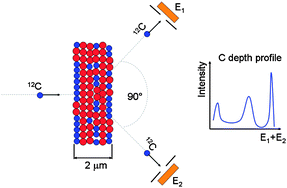Technique for sensitive carbon depth profiling in thin samples using C–C elastic scattering
Abstract
A technique for carbon depth profiling in thin samples is described. It is developed to analyze low concentrations of carbon in heavier matrices. The method is based on the carbon–carbon elastic scattering coincidence measurement. Recoiled carbon atoms as well as scattered carbon ions from the primary beam are detected by two solid state detectors placed symmetrically at 45° around the beam direction. Since scattering products are detected in the forward direction, the method can be applied only for transmission samples with thicknesses of the order of several micrometers. Capabilities of the technique concerning depth resolution and sensitivity were tested on samples with known composition and depth distribution of carbon.


 Please wait while we load your content...
Please wait while we load your content...